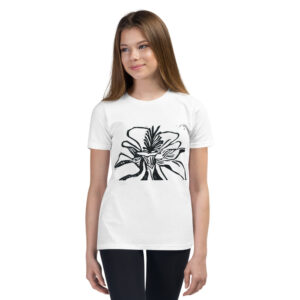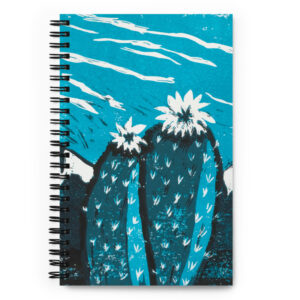
Hand Printing
Hand Printing Linocuts is the part of the process where you can see if your techniques up until this point will work out. A lot of printmaking has to do with the process, design, and technical steps. Once you get the hang of the steps involved it can be a very therapeutic and rewarding process.
Once the block of linoleum is carved out completely (or before for proofing), you can start the inking and printing portion of printmaking at home.
Tools for Hand Printing
This post contains affiliate links, which generates some small commissions at no extra cost to you. This commission helps keep this blog and shop running. Thank you for your support. See my disclosure form for more information.
Baren
A baren is an even, flat, round tool used to apply even pressure onto a larger surface of the paper when printing. In Japan, one that is wrapped in bamboo is traditionally used. This one in the photo is called a Yasutomo Bamboo Baren.
I have one and it is very useful for printmaking at home. I like it because it has an eco friendliness about it. Since it is made from a sustainable material such as bamboo.
Spoon
Yes, I said spoon. A large wooden or metal spoon is fantastic to start making prints. I started out with just an old tablespoon. I used that for a few years until I learned more about the process and decided to invest in my printmaking.
The surface area is not as big when you use this method for printing, but it is effective.
Printing Press
I have shared here before about the kind of printing press I use for printmaking in my post about transfer methods. The one in this post is as close as I could find to the one I use.
You can use a book press to make prints, a letterpress, an etching press, a homemade press, or a steamroller. Basically anything that will allow for enough even pressure to be applied to your print.
The other day I read about a woman using her car to press her linocut. Lol. I am not sure I would recommend this, unless you had some solid blocks of wood to ensure even pressure. If any of you try this method, please send me photos. I would love to see the results.
Registration
Registration is where you make either marks or have guides to ensure that your paper and your linoleum line up completely the same each time you make a print. This is fantastic when you need to make a reduction or a multi block print.
One of the easiest ways to ensure proper registration is to use a larger piece of paper under the size of paper you are going to print with. On the bottom sheet of paper (this can be any kind of paper) outline the sheet of paper you are going to print with.
Then lift that sheet off and then set down your linoleum and mark out that area centered on the bottom sheet.
You can mark a few straight line markingings in pencil from your sheet of paper you will print with onto the bottom sheet of paper.
You can learn about other registration methods here.
Brayer

In order to roll the ink out onto your linoleum you will need a brayer. I use a soft rubber brayer that is about 4 inches wide. You can use any size you wish. Some prefer a hard rubber brayer, but I have found rolling out the ink this way is more difficult for me.
When you roll out the ink you want to make sure the consistency is good. It should not be too tacky or too runny. It should be just right. Lol Well yeah, it should roll easily and start to smooth out.
Rolling out the Ink

When you roll it out on a smooth surface you will start to hear the ink hiss. SSSSSsss It sounds a little silly, but honestly, try it. You will see. The ink hisses.
Now, depending on the kind of ink you use, or the age of the ink will determine how much time you have to actually print.
Ink
If you are using water based inks, which are very easy to come by. Sometimes they say they are for “Block Printing” which will dry out quicker. And by quicker, depending on your environment this can be within a few minutes. So you will need to work a lot quicker.
For me this working quickly, kinda freaks me out a little. So, I prefer to use oil based inks for printmaking.
I will be reviewing some of my favorite inks I have tried soon. If you would like to hear about this be sure to subscribe to the blog.
With oil based inks at home I use the ones marked “Safe Wash” these require no special chemical clean up methods. Which I prefer.
Carved Linocut

In order to make a final print you will first need to carve a linoleum block. I have more about this process here.
What You Will Need
Ink
Printing paper
spoon/baren/or press
Registration guides
Carved Linoleum
Brayer
Flat Inking surface
Directions
1.Be Sure to start with a finished carving of your linoleum
2. Make your registration guides. This takes some prep work but is so worth the effort
3. Use a small popsicle stick to scoop out a small amount of ink (about the size of a quarter). Place it on your smooth inking surface
4.Use your brayer and start rolling back and forth onto the surface. The surface should start to hiss and smooth out and lay out very flat
5.Use that brayer to smoothly and evenly apply the ink onto the linoleum.
6.Make sure the entire surface has a good amount of ink on the surface, but not globs of ink.
Guides
7. Line up the linoleum in the center of your guide paper
8. Gently place and line up your printing paper on the guide paper above the inked linoleum
9. Hold firmly with one hand and with the other use your spoon or baren to firmly apply pressure onto the surface of the printing paper
10. Depending on what kind of paper you use, this could take a few moments of pressure or a few minutes.
11. Firmly rub the back of the paper around the entire surface of the linoleum. If the paper is a little too thin, you can use a sheet of copy paper and place it between the spoon or baren and the sheet of the printing paper. This will prevent tearing.
12. Make sure to switch hands so you get both sides of your printing surface.
13. When you are ready to see your print. Hold one side down and lift one corner with the other hand. With authority, but not aggressively, lift the sheet of printing paper off of the inked linoleum.
Congratulations!
You should have a finished print. Congratulations!!!
That part is absolutely my favorite. (not a step, but just thought I’d share)
You can repeat this same process of hand printing with other blocks or by reduction. I will go over this in future posts.
Hang or lay flat to dry. Depending on what kind of ink used this could be a few minutes or a few days.
Congratulations! You made a linocut print! Please share with me your progress. I would love to help you in your journey to home printmaking. Please email me if you have any questions.


